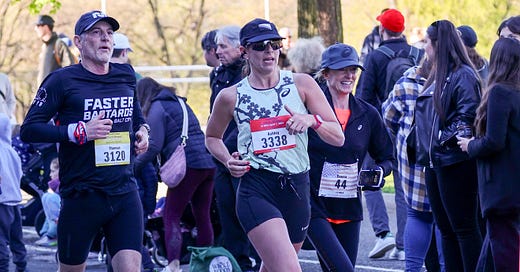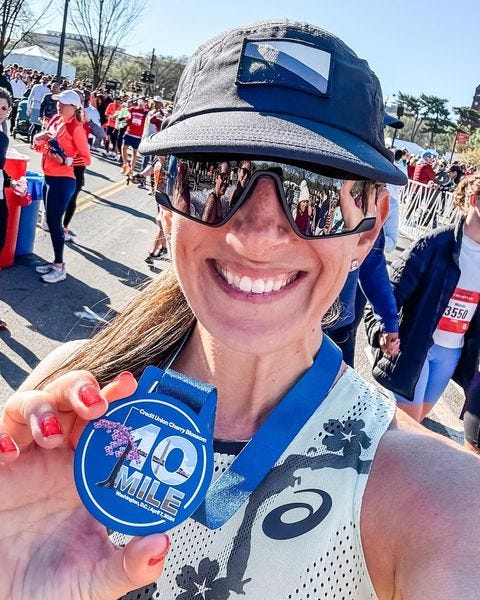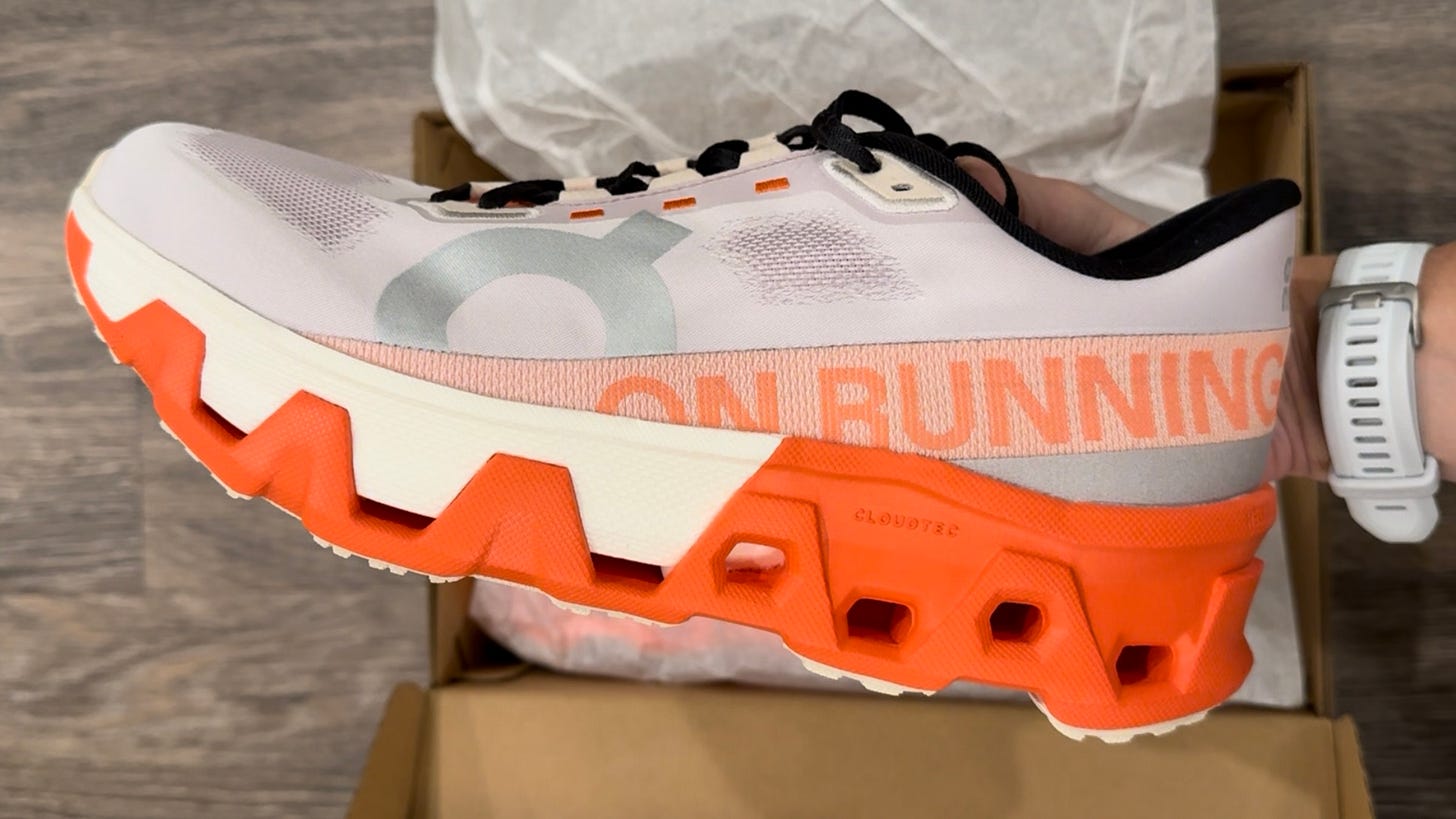I’ve run 15 marathons, 25 half marathons, and too many 5Ks and 10Ks to count, but I think the less traditional distances are underrated. There’s the Falmouth Road Race, which is seven miles; the 10-mile Broad Street Run in Philadelphia; the Bronx 10 Mile; and a slew of smaller four-, seven-, and 10-mile local races. If any race makes a great case for racing a non-traditional distance, it’s the Cherry Blossom 10 Miler.
This is a huge event, drawing nearly 20,000 runners to the nation’s capital around peak cherry blossom season, when the city is already teeming with tourists. The timing makes for great spectator crowds and (ideally) great on-course scenery.
The course itself starts and finishes at the Washington Monument. A cruise-y downhill mile kicks things off before you head across the Potomac River and back via Memorial Bridge. Two out-and-backs along Rock Creek Parkway run past the Kennedy Center, then a loop around the Tidal Basin takes you out to East Potomac Park (“Hains Point”). The finish brings you back to the Washington Monument. It’s a super flat course—Strava recorded about 110 feet of gain— which can make it very fast if you’re not battling wind along the mostly exposed route, and as long as you save some energy to tackle the main uphill heading into the finish.
I ran this race back in 2022, but I did it as part of a 20-mile long run. Actually, because I’ve run so many marathons in a relatively short amount of time, that’s how I’ve run a lot of shorter races. It’s a great way to keep marathon training interesting, but it means I’ve rarely prioritized training specifically for those shorter distances.
In taking a break from marathons, I wanted to focus on shorter efforts. (The long-term goal is to eventually translate that top-end speed into a faster marathon marathon pace.) Back in 2022, I ran a 7:46 average pace for a 1:17:42 finish after an 8-mile warmup, so this year my main goal was just to beat that. I felt pretty confident that I could hold somewhere in the 7:30s, especially without that extended warmup. The strategy: start around 7:35, settle into the 7:25-7:30 range for 6 miles, then hit the gas to go sub-7:25 in the last three miles.
Sunday was perfect running weather. The wind that had whippepd all the cherry blossoms off the trees earlier in the week had (mostly) calmed down, the sun was out, and the temperature was crisp. All good omens.
What I didn’t account for was the crowds. I’m pretty sure the race was not quite at full capacity in 2022 due to Covid-19 restrictions, but it certainly was this year. I made the mistake of starting too far back in my corral, which was my bad, but I do think, given the massive size of the race and the narrow streets, organizers could do a better job of staggering the corrals to prevent bottle-necking at the turns. I spent a good portion of the first half of this race weaving around other runners, which—combined with an alarming number of potholes in the roads—made for a very mentally stressful start (I saw at least three runners fall within the first mile).
My first mile was 7:45, a bit slower than I wanted, but then I settled into the mid-7:20s for four miles. I was surprised by how effortless the pace felt until mile 6, when I slowed just a bit to 7:29 and then 7:31 for the next two miles as we baked under the sun on the west side of Hains Point, before battling a headwind on the east side.
But I was able to find that finishing kick in the last two miles, dropping back down to a 7:27 and then a 7:10. Heading into the final 800 meters, I got a major boost when I ran into Thomas Neuberger from Believe in the Run and Olympian Deena Kastor, who held the American women’s marathon record for 16 years (captured above by Chase Fleming). I was about 0.15 miles over 10 thanks to all that weaving at the start, and that finishing kick was a speedy 6:28—I definitely couldn’t have sustained that for much longer, but you can’t slow down when you’re finishing next to Deena.
I’m super proud of this effort, not just because I hit my goal and PRed by two minutes, but because I ran negative splits while executing my race strategy nearly to perfection. That’s always my intention, but I’ve actually rarely done it on race day. I definitely felt like I could have run a little faster if I had been in the right pace group—but overall I felt strong, in control, and like I was exactly where I was supposed to be. This was one of my best race performances physically and mentally, and I feel like it was a great benchmark for future events.
Fun fact: This year’s race also happened to be the USATF's 10 Mile Championships, and the way the course is set up with multiple out-and-backs allows regular runners like me to cheer for pros like Emily Durgin, who came within seconds of beating Keira D’Amato’s American record, and Hillary Bor, who came in second but beat his own American record by 15 seconds. I said this about the Tokyo Marathon, too, but I kind of love courses with multiple out-and-backs because it just feels so much more exciting to see other runners at different parts of the race!
I have to give a huge thanks to ASICS for inviting me to run—I wore the ASICS Metaspeed Paris Sky, the latest version of the shoe I wore for the Tokyo Marathon, and I loved every step in it. Even with the potholes and constantly dodging of other runners at the beginning, I felt so stable in these (which is not the norm for race day super shoes!). These are so light and airy, too, and I could really feel the pop underfoot as I picked up the pace.
If you’re considering Cherry Blossom for next year and looking to switch up your distances, I can’t recommend this race more. Crowded as it is, it’s a very organized event overall, a beautiful course (with or without the actual cherry blossoms), and a great way to kick off a summer of speed training. I’ll definitely be back again!
the rundown
On Cloudmonster Hyper
I know Ons look cool, but I have never been able to comfortably run in them for more than a few miles—including maximally cushioned models like the Cloudmonster and Cloudmonster Eclipse. The Cloudmonster Hyper finally bucks that trend, thank god. The shoe is slightly lighter than the two mentioned above, and features a new Pebax-based superfoam called Helion HF hyper foam, which is used in lieu of a speedboard to better absorb impact and promote bounce, atop their standard CloudTec cushioning. That combo makes it great for racking up daily volume and for long runs, and I found this shoe to be noticeably softer and more responsive than any other On shoe I’ve ever tried—and I’ve comfortably done about 7 miles in these at a time, which is a first with the brand. These might be a good option for anyone who’s struggled with On in the past.
The Detroit Free Press Marathon Adds An Elite Field
I saw on Twitter last week that the Detroit Free Press Marathon—which crosses the U.S.-Canadian border twice—is adding an elite field, and this article explains the reasoning behind that change and what the race hopes to gain from it. A move like this helps elevate the reputation of a race on a global stage, which will eventually draw more non-profressional racers as well. I think there’s a real opportunity right now for smaller races to grow; marathoning has never been more popular, and the harder it gets to gain entry into the biggest and most prestigious races (see: the World Marathon Majors), the more runners will be looking elsewhere for similar opportunities. It’ll be awesome to see what kind of growth this move leads to for the Detroit Free Press Marathon.
Creatine Supplementation Boosts Recovery
Last year, I wrote about creatine for depression and learned that this is one of the safer supplements out there. A new study from the journal Nutrients extolled its recovery benefits: Supplementing with creatine for 28 days (3 grams per day) was shown to reduce muscle damage and improve recovery after muscle-damaging exercise. Considering that even one gram a day can lower the risk of depression and the body can safely handle up to 30 grams a day, this seems like a win-win. The only side effect I’ve been warned about is potential weight gain as a result of water retention.
Bose Ultra Open Earbuds
I’ve worn the same pair of earbuds for more than 10 marathons, but after testing Bose’s new open-ear headphones during multiple training runs and the Cherry Blossom 10 Mile Race, I’ll never go back. As someone who won’t race without sunglasses and occasionally adds a hat to the mix, I love that these cuff-like headphones clip on to the side of each ear, so there’s one less thing adding pressure to the same spot. In fact, they’re so light—just 0.22 ounces each—I almost always forget I’m wearing them. And despite the open-ear style, which allowed me to chat with other runners throughout the race, the audio is still pretty spectacular thanks to Bose’s immersive 3D sound platform. They definitely look a little odd, but the side-eyes from other runners are a small price to pay.








Great race & love your recap. I volunteered this year handing out medals to secure my bib for next year. Wish I could’ve said hello! Glad you had a great run & hope to see you there next year!!